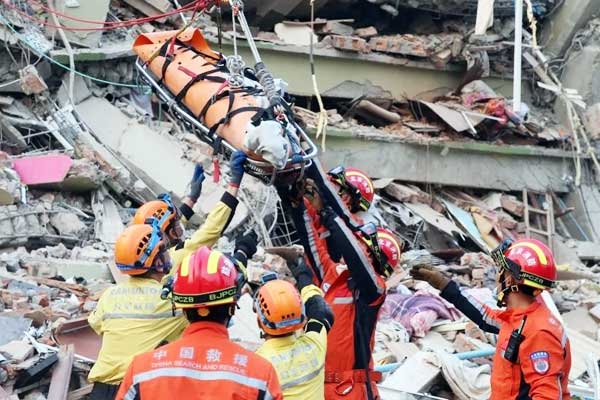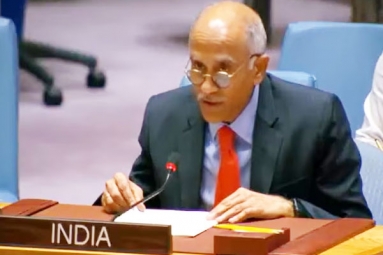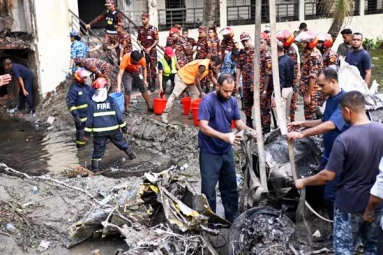
(Image source from: AP)
The latest reports indicate that the death toll from last week’s devastating 7.7-magnitude earthquake in Myanmar has surpassed 2,700. Additionally, over 4,500 individuals have sustained injuries, and many others are unaccounted for, as stated by the ruling military junta on Tuesday, according to Reuters. In a televised address, Myanmar's military leader Min Aung Hlaing announced that the confirmed number of fatalities has reached 2,719 and is anticipated to exceed 3,000. He also indicated that the number of injured individuals is 4,521, with 441 still missing. As rescue teams continue to search through the debris of fallen structures, concerns are growing that the casualty count might escalate in the days ahead.
Most information has so far emerged from Mandalay, the country’s second-largest city, which is close to the earthquake's epicenter, as well as from Naypyidaw. Rescue and recovery operations were briefly halted on Tuesday to allow individuals to observe a moment of silence in honor of those who lost their lives. Occurring around midday on Friday, the 7.7 magnitude quake marked the most severe seismic event in over a century for the Southeast Asian nation, leading to the collapse of ancient pagodas alongside contemporary buildings. In light of the disaster, Myanmar’s military government has announced a state of emergency as efforts to locate the trapped continue.
Rescue teams and humanitarian organizations operating in the most severely affected regions of Myanmar have highlighted an immediate need for shelter, food, and water for survivors. However, they caution that ongoing civil conflict may hinder assistance from reaching those in urgent need. According to the United Nations Office for the Coordination of Humanitarian Affairs (OCHA), the tragedy struck a preschool in Mandalay, resulting in the deaths of 50 children and two teachers when the building collapsed. Aid groups have raised alarms about shortages of food, clean water, and medical supplies, with many displaced individuals now having to sleep outside. The UN reported that in the areas hit hardest, communities are struggling to secure basic necessities, including access to sanitation and clean water, even while emergency teams tirelessly work to find survivors and deliver crucial aid.
Although foreign aid workers have begun to arrive slowly to assist with rescue operations, progress remains sluggish due to a shortage of heavy machinery in many regions. International rescue teams from various nations, including Russia, China, India, the United Arab Emirates, and several Southeast Asian countries, are on the ground. In one location in Naypyidaw on Tuesday, workers formed a human chain to pass debris, such as bricks and concrete, out from the wreckage. The International Rescue Committee has emphasized that areas near Mandalay, which is close to the earthquake's epicenter, are in dire need of shelter, food, water, and medical support.
"Following the traumatic experience of the earthquake, residents are now anxious about potential aftershocks, prompting some to sleep outdoors on streets or in open fields," stated an IRC worker located in Mandalay, according to the report. The World Health Organization has noted that over 10,000 structures have either collapsed or suffered significant damage in central and northwestern Myanmar. Amnesty International has urged the Junta to permit unrestricted humanitarian access to the regions impacted, particularly those that remain beyond its control.
In Bangkok, Thailand, authorities have confirmed at least 20 fatalities resulting from the collapse of a high-rise building currently under construction, with concerns that the death toll may increase as recovery efforts continue. Search teams persist in their operations at the site where the tower fell, as 74 individuals are still unaccounted for and may be trapped beneath the wreckage. While rescuers hold out hope for finding survivors, they recognize the likelihood is decreasing given that four days have elapsed since the disaster. "There are close to 70 bodies buried beneath the debris…and we are clinging to the hope that by some miracle, one or two individuals might still be alive," remarked Bin Bunluerit, a leader of the volunteer rescue efforts. Bangkok’s deputy governor, Tavida Kamolvej, confirmed that scanners have identified six human figures; however, there were no indications of movement or life.
As a rapid response measure, India dispatched over 400 tonnes of humanitarian aid to the affected East Asian nation on Tuesday under Operation Brahma, utilizing naval ships INS Satpura and INS Savitri. The Indian Embassy in Yangon reported that six Indian Air Force aircraft and five navy vessels have delivered supplies to Yangon, Naypyidaw, and Mandalay. An additional aid shipment is on the way, with three more navy ships—INS Karmukh, INS Gharial, and LCU-S2—bringing over 500 tonnes of relief materials to Yangon. Additionally, a JAF C-130 aircraft is anticipated to land in Mandalay today carrying 15 tonnes of extra supplies.
A field hospital staffed by specialists from the Indian Army is now functioning at the old airport in Mandalay, the area most severely impacted by the quake. An 80-member search and rescue team from the National Disaster Response Force (NDRF) is actively searching through debris at more than a dozen locations in Mandalay in their quest for survivors.







